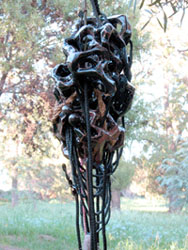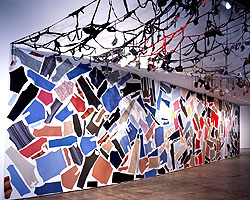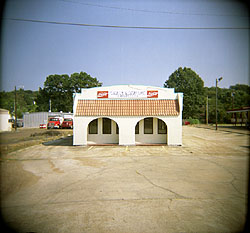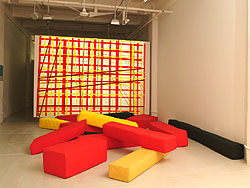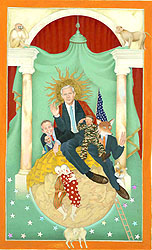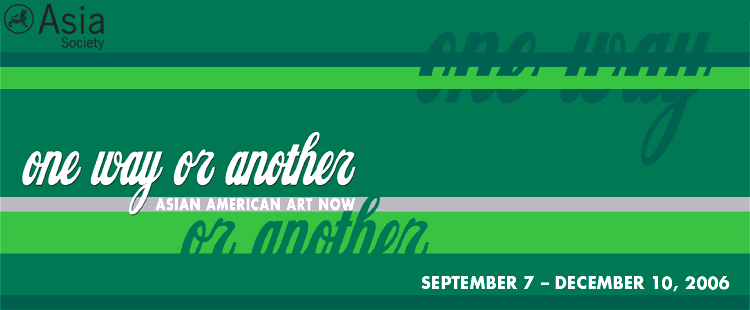 |
ARTISTS IN THE EXHIBITION Michael Arcega | Xavier Cha | Patty Chang | Binh Danh | Mari Eastman | Ala Ebtekar | Chitra Ganesh | Glenn Kaino | Geraldine Lau | Jiha Moon | Laurel Nakadate | Kaz Oshiro | Anna Sew Hoy | Jean Shin | Indigo Som | Mika Tajima | Saira Wasim |
|
Anna Sew Hoy’s assemblage is an organic, porous mass of fired ceramic knots, beads, charms, entwined rope, and chains. For One Way or Another, she has produced Dreamcatcher, inspired by unconscious states of being. Though her creations appear random in their composition, Hoy actually constructs her fantastical sculptures by drawing on traditions of Japanese Ikebana, meticulous flower and foliage arranging. She upends any traditionally balanced arrangement here though, and is rather interested in the clash between the handmade, the natural, and the mass produced. One might notice references to traditional Chinese scholar’s rocks within Hoy’s ceramic installations. While she looks to some visual precedents from China and Japan, her work simultaneously offers a sampling of transnational and pop culture images and art historical commentary. Excerpt from artist’s statement “The detritus of modern life is organized into something dynamic, energetic, moody, and turbulent. I work by smashing, slapping, and cobbling things together by collage. Any object or material may be used, such as perfume bottles, sweaters, furniture, toys, or charms. I zoom in on the object and try to give it a new life, realize its potential to be transformed and to achieve new meaning or significance.”
|
|
|
To produce Unraveling for One Way or Another, Jean Shin used sweaters that were all donated by members of the Asian American community, including the curators of this exhibition, museum staff, and other artists. In this way, the installation is an abstract reflection of all these contributors; in some respects, it is also a trace of many people whose background labor helped to create this exhibition. The silkscreened labels on each sweater also work to bring more Asian American “bodies” into this forum and in conversation with each other, with the museum, and with viewing audiences. Other installations by Shin, such as Cut Outs and Suspended Seams (2004), have also involved the deconstruction of clothing in order to produce a woven, colorful web of textures and form. Once taking on the shapes and sizes of multiple bodies, the clothing intersects in abstract linear patterns and maps the space of the gallery with personal histories. In Unraveling, Shin’s work also plays with the notion of a “family tree” and “degrees of separation” as the connected sweaters reflect a pre-existing relationship between people. Each sweater line thus traces personal exchanges or meetings within their community. In their diversity of colors and styles, the sweaters in Unraveling also underscore vast differences within the Asian American community, raising the question of how identities define and connect us to others, and the ways in which we either embrace or resist those connections. Excerpt from artist’s statement “My work incorporates and transforms cast-off materials that are familiar to us, such as articles of clothing, umbrellas, and used lottery tickets. The process of making the work is unconventional, involving participation of a larger community of individuals in order to accumulate the materials for the work. The finished installation reflects how society collectively relates to these objects while making a connection with a specific space.” |
|
|
Issues of identity and authenticity figure largely in the photographic work of Indigo Som’s. She is interested in exploring the heterogeneous nature of cultural existences in America, referring here to her experiences as a Chinese-American growing up in California. Som’s photos in One Way or Another consider how culture becomes imprinted within the American landscape. She turn the lens onto ubiquitous Chinese restaurants in the most isolated parts of the country. How do these restaurants function as thresholds between American-ness and Chinese-ness? Or between notions of the “norm” and the “exotic”? Artist’s Statement “That’s just the way it is. |
|
|
In Broken Plaid (2003) and Extruded Plaid (Suicidal Desires) that was created for One Way or Another, Mika Tajima started with a basic flat plaid pattern and then transformed it into a three-dimensional architectural space by deconstructing its strict grid design. Tajima is interested in challenging the ideals of classic modernism, characterized by clean lines and geometric forms. Her work often morphs sculpture into furniture, integrates video and wallpaper, or transforms sound and clothing into sculpture. By challenging the boundaries of all these media, she reveals their double identities and often unsettling social functions. The video in this installation documents a concert performed by Tajima on the opening night of this exhibition. How does the insertion of music into this space alter our reception of her remade grid pattern and its angular forms? Excerpt from artist’s statement “I employ various strategies that often contradict, and I never favor one over the other. This approach is crucial in my understanding of how we locate ourselves and how we can negotiate seemingly overdetermined situations and structures. Pattern is used as a representation for these systems; form is a shell to be applied and continually replicated towards disintegration.”
|
|
|
Saira Wasim’s intricate paintings take many of their cues from repetitive media messages and messages of political propaganda from the United States and Pakistan. Sharply insightful and acerbic in her observations, Wasim is fearless in her comments on contemporary relations of power, global hypocrisies, war, and political posturing. She examines this socio-political pulse by drawing on the artistic style, symbolism, and vivid natural colors found in South Asian traditions of miniature painting. New World Order (2006) is a clever example of this synthesis of tradition and the contemporary. It presents us with a roster of international leaders on a literal world stage, preparing for their cameos: Tony Blair and Hamid Karzai peek around the imposing figure of George Bush who sits like a ventriloquist with his doll, Pervez Musharraf. The aura of flames around George Bush’s head is a direct reference to Mughal rulers in South Asia who projected themselves as the center of the universe in 16 th century paintings, emanating divine light as evidence of their sacred legitimacy to rule. Excerpt from artist’s statement “My work uses the contemporary miniature form to explore social and political issues that divide the modern world. This series, Battle for Hearts and Minds, illustrates the clash between imperialism in the west and fundamentalism in the east, and questions the underlying motivations and uneasy alliances that keep this conflict going. My work offers a voice against this ignorance and prejudice. It pleas for social justice, respect, and tolerance through the use of caricature and satire.”
|
|
| © 2005 Asia Society | 725 Park Avenue at 70th Street NY, NY 10021 | 212-288-6400 | Press Releases | Contact | FAQ | Become a Member
|
